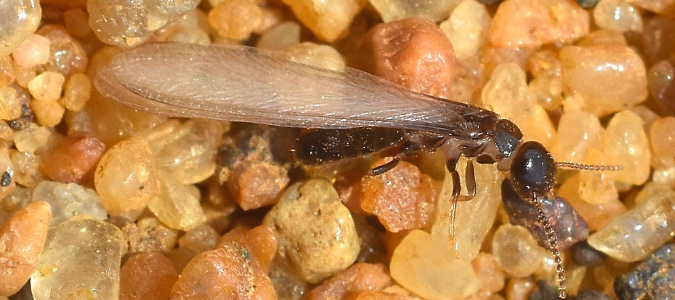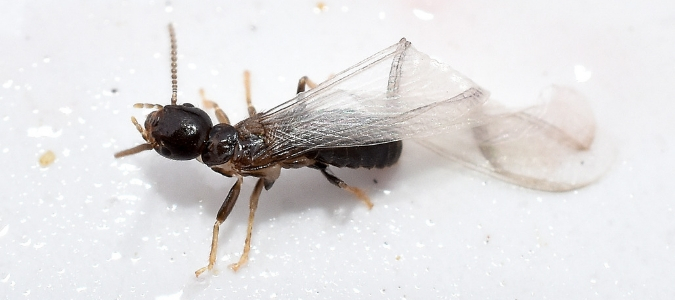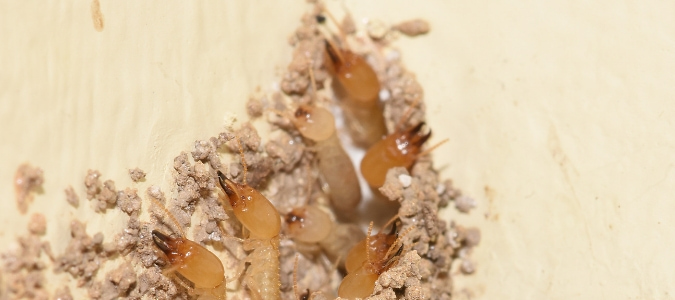
During the spring, homeowners may begin to notice animals and plants that may have been inactive or dormant during the coldest months of the year.
While blooming plants and baby animals make most of us feel warm and fuzzy inside, some creatures that become more visible when the temperatures climb are less likely to inspire the same kind of positive feelings. One example? Termites.
If you see a flying bug with wings, you might be seeing an ant, but you could be seeing a termite. If you spotted the latter, you want to nip the problem in the bud as fast as possible. You probably already know why, but just to give you a reminder, we’re going to hit the highlights real quick.
Why should you jump into action if you see termites?
We all know that fire and natural disasters can do a lot of expensive damage. Did you realize that termites cause more damage than fires and all natural disasters combined?
Current estimates show that termites are responsible for more than $5 billion worth of property damage in the U.S. annually.
Worse, termites do most of their damage in hiding. Once they get inside your living structure, these dangerous pests can literally eat away at your home for months—or longer—without your ever knowing.
So, if you see swarming flying termites, it can mean one of two things:
- You’re lucky to catch them before they could infest your home, and this is your chance to stop them without having to deal with massive damage.
- Your home has already been invaded and you’re seeing swarmers who are leaving to set up a new colony. This is by far the worse option, because it means the swarmers are the tip of the iceberg and an indication that you could have a much, much bigger issue that is probably going to cost you.
Whichever situation you find yourself in, though, your reaction needs to be the same: get rid of termites by calling in a knowledgeable exterminator immediately. Don’t just take it from us, as this is also what the Environmental Protection Agency, government institutions at the state and local level and the USDA recommend.
In the first scenario, you can stop things before they start to get bad. In the other, you keep your infestation from getting worse. No matter how bad it is, believe us when we say they can get worse.
No need to hit the panic button just yet. You’re not even positive you’re dealing with termites, right? If you’re not quite ready to call in the experts, you should focus your efforts on learning everything you can about termites so you understand how to best protect your biggest investment.
In this post, we’re going to tell you how you can identify swarming termites, what it means if you have swarmers and what you can do to get rid of any termites that might invade your property.
What Do Swarming Termites Look Like?
The frustrating thing about termites is that they are not particularly easy to identify unless you actually rip open a piece of wood and discover them inside—and even then, it’s possible that you could be dealing with carpenter ants.
Speaking of, people often confuse ants with termites—and vice versa—so that’s one thing to be wary of. The biggest thing you should ask yourself is: am I really looking at a termite, or is it a species of ant?
Here are some ways to tell if what you are looking at are swarming termites:
- They’re small, usually between a quarter and a half inch long.
- Their bodies are tri-segmented (they have a head, thorax and abdomen) and the color of honey or cream. That said, the body color may range from light-colored to dark brown or black, depending on the termite species.
- They have six legs.
- They also have two pairs of wings, the specific color of which varies by species and may range from grey to pale brown.
How can you tell swarming termites from winged ants?
To differentiate the two, look for the following features:
- A termite’s antennae are straight, while those of an ant are bent.
- The abdomen of a termite is straight, while that of an ant is pinched.
- Both pairs of the wings on a termite are of equal size. On an ant, the front pair of wings is usually longer than the back pair.
If you’re thinking that telling the two insects apart seems difficult, well, it is. Especially when you consider that most people aren’t really going to be able to study an ant and a termite side by side to compare the two.
That’s why it’s often best to have a trusted pest professional come out to take a look.
There is another clue you can use in addition to physical features: whether or not it’s swarming season.
Termite Swarmers’ Season: What Should I Know?
Swarming season is when termites reproduce. Termites with wings are sexually mature adults that venture out of the colony to spawn new generations. The technical name for these termites is alates, but they’re more commonly known as swarmers.
Termite swarms frequently appear in spring. Numbers usually progressively decrease towards the end of June as the supply of alates within the termite colonies gets depleted.
Don’t take this as gospel, though. Swarming in termites isn’t based on a particular calendar, and it’s not unheard of for these insects to appear in the fall.
Generally speaking, swarmers appear when temperatures get close to or exceed the 80-degree mark and there’s been a warm rain shower. These insects like it when the ground is moist, the air is warm and humid and the sky is overcast and not too windy.
How long do termites swarm? Most of the time, termite swarms come out from around dusk till about 11 pm. Again, though, this isn’t set in stone. They may continue coming out throughout the night.
What does this mean?
If many of those conditions are present when you notice a swarm of insects that look like they might be termites, there’s a higher likelihood that it’s these insects you are seeing.
Do Swarming Termites Mean An Infestation?
Swarmers come out of a colony when that colony is mature and needs to expand. It takes approximately three to four years for a colony to reach that point. So, when you see termites swarming out of a colony, that colony is likely at least three years old.
Now for the million-dollar question: if you see a swarm of termites near your house, does that mean there’s a colony inside?
If you’ve been paying attention, you already know the answer: not necessarily. Termites swarms may emanate from colonies inside or near the house.
A colony that’s gotten inside the house may be revealed by swarms that exit through crevices or gaps in the house walls or paneling. However, it’s important to note that even when the colony isn’t in the house, termites may still be getting into your home through the mud tunnels they build.
Regardless of whether the colony is inside the house or not, what you really need to know is how much damage has already been done. So, you should look for additional signs you have termites to determine if you have an infestation. These can include the following:
General Damage
One of the easiest and relatively accurate ways of determining whether termites have caused any damage to wood is by jabbing it with a screwdriver, icepick or awl. The sharp point of the screwdriver (or whichever tool you might be using) will easily sink into rotten or termite-infested wood. This is because termites will usually eat out the interior, leaving behind a flimsy shell—and in some cases, just a thin paint film.
Hollow Wood
Termites eat and destroy wood from the inside out. These dangerous pests can also feed on almost all other cellulose-based materials in a home, including drywall, boxes, books and furniture.
Frass
You may find this insect’s waste material inside or around wood that’s been damaged by termites. Termite frass looks like very fine sawdust, so it’s not always easy to identify.
Mud Tunnels
One of the biggest telltale signs of termites that have set up shop on a property include mud tunnels leading from the ground and running along the walls of a house’s foundation and crawl spaces.
Wings
If termites swarm in the middle of the night, you’re probably not going to be out to see them. However, that doesn’t mean you won’t know they were there. How? The wings we mentioned earlier. These discarded body parts are a classic calling card of swarming termites. If you find papery wings on the floor, ground or around windows and doors, there’s a good chance swarmers were there.
How To Get Rid Of Swarmer Termites
Swarming termites aren’t directly responsible for causing damage to property. Most don’t even live long enough.
The real home destroyers are the worker termites, so your efforts should mostly be aimed at getting rid of any wingless termites living in colonies in or around the house.
The control of termites generally involves the application of termiticides. The process requires special equipment and knowledge—things the average homeowner doesn’t possess.
Because of this, termite control isn’t a do-it-yourself kind of project. You will need a reputable termite treatment professional with extensive pest control experience to get rid of swarming termites and identify and treat termite problems at their root cause. This is the best way to ensure these troublesome and voracious insects are all eradicated and do not return.
ABC Can Resolve Your Termite Troubles
One of the best parts of working with a professional experienced in termite control is that they will not only remove your current problem, but also protect your property from future invasions. ABC Home & Commercial Services uses scientifically-proven termite treatments that create a protective barrier around your home. We can also provide you with a termite inspection if you aren’t sure you have a problem. If your home is treated, we can also install monitoring devices to make sure termites don’t get too close for comfort.



